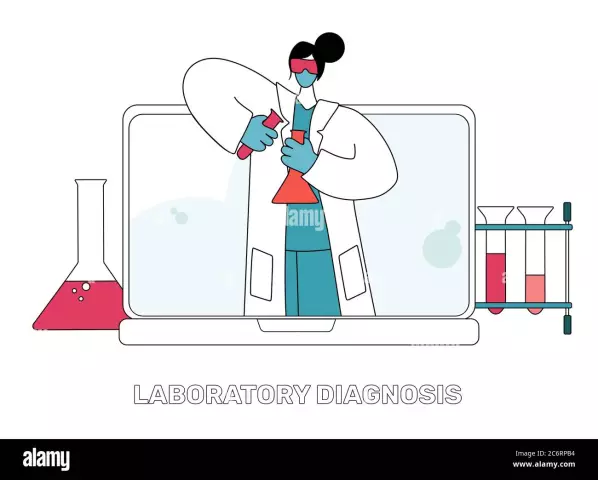- Author Curtis Blomfield [email protected].
- Public 2023-12-16 20:44.
- Last modified 2025-01-23 17:01.
The large number of existing diseases, the individual degree of symptoms in different people complicate the process of diagnosis. Often, in practice, it is not enough to use only the knowledge and skills of a doctor. In this case, clinical laboratory diagnostics helps to make the correct diagnosis. With its help, pathologies are detected at an early stage, the development of the disease is monitored, its possible course is assessed, and the effectiveness of the prescribed treatment is determined. Today, medical laboratory diagnostics is one of the fastest growing areas of medicine.

Concept
Laboratory diagnostics is a medical discipline that practices standard diagnostic methods for detecting and monitoring diseases, and is also engaged in the search and study of new methods.
Clinical laboratory diagnostics greatly facilitates the diagnosis and allows you to choose the most effective treatment regimen.
Subsectors of laboratory diagnosticsare:
- clinical biochemistry;
- clinical hematology;
- immunology;
- virology;
- clinical serology;
- microbiology;
- toxicology;
- cytology;
- bacteriology;
- parasitology;
- mycology;
- coagulology;
- laboratory genetics;
- general clinical studies.
Information obtained using various methods of clinical laboratory diagnostics reflects the course of the disease at the organ, cellular and molecular levels. Due to this, the doctor has the opportunity to timely diagnose the pathology or evaluate the result after the treatment.

Tasks
Laboratory diagnostics is designed to solve the following tasks:
- continuous search and study of new methods of biomaterial analysis;
- analysis of the functioning of all human organs and systems using existing methods;
- detection of a pathological process at all its stages;
- control over the development of pathology;
- assessment of the result of therapy;
- accurate diagnosis.
The main function of the clinical laboratory is to provide the doctor with information about the analysis of the biomaterial, comparing the results with normal indicators.
Today, 80% of all information important for diagnosis and treatment management is provided by the clinical laboratory.

Types of test material
Laboratory diagnostics is a way to obtain reliable information by examining one or more types of human biological material:
- Venous blood - taken for hematological analysis from a large vein (mainly in the crook of the elbow).
- Arterial blood - most often taken to assess the ABS (acid-base state) from large veins (mainly from the thigh or area under the collarbone).
- Capillary blood - taken for many studies from a finger.
- Plasma - it is obtained by centrifuging blood (i.e. dividing it into its components).
- Serum - blood plasma after the separation of fibrinogen (a component that is an indicator of blood clotting).
- Morning urine - collected immediately after waking up, intended for general analysis.
- Daily diuresis - urine that is collected in one container during the day.
Steps
Laboratory diagnostics includes the following steps:
- preanalytic;
- analytical;
- post-analytical.
Pre-analytical stage implies:
- A person's compliance with the necessary rules for preparing for analysis.
- Documentary registration of the patient when appearing at a medical facility.
- Signature of test tubes and other containers (for example, with urine) in the presence of the patient. The name and type of analysis are applied to them by the hand of a medical worker - he must say these data aloud to confirm their reliability by the patient.
- Further processing of the taken biomaterial.
- Storage.
- Transportation.
The analytical stage is the process of direct examination of the obtained biological material in the laboratory.
Post-analytical stage includes:
- Documentation of results.
- Interpretation of results.
- Generation of a report containing: data of the patient, person who conducted the study, medical institution, laboratory, date and time of biomaterial sampling, normal clinical limits, results with relevant conclusions and comments.

Methods
The main methods of laboratory diagnostics are physical and chemical. Their essence is to study the material taken for the relationship of its various properties.
Physico-chemical methods are divided into:
- optical;
- electrochemical;
- chromatographic;
- kinetic.
The optical method is most often used in clinical practice. It consists in fixing changes in a beam of light passing through a biomaterial prepared for research.
The chromatographic method is in second place in terms of the number of analyzes performed.
Probability of errors
It is important to understand that clinical laboratory diagnostics is a type of research in which mistakes can be made.
Each laboratory should be equipped with quality instruments, analyzes shouldcarried out by highly qualified specialists.
According to statistics, the main share of errors occurs at the pre-analytical stage - 50-75%, at the analytical stage - 13-23%, at the post-analytical stage - 9-30%. Measures should be taken regularly to reduce the likelihood of errors at each stage of the laboratory study.

Clinical laboratory diagnostics is one of the most informative and reliable ways to obtain information about the he alth of the body. With its help, it is possible to identify any pathologies at an early stage and take timely measures to eliminate them.






